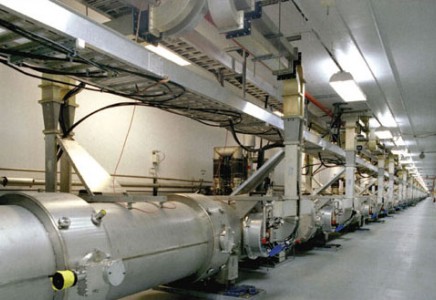Experiment Research

Jefferson Lab's accelerator is shaped like an oval racetrack and is located 25 feet below ground. This is a view of one of the straight sections, showing the cryomodules linked end to end in the accelerator tunnel.
Jefferson Lab has an ongoing and ambitious experimental program. Most experiments carried out with the Continuous Electron Beam Accelerator Facility (CEBAF) are in the field of nuclear physics and can be described in terms of the following.
Structure of the Nucleus
Here at Jefferson Lab, we study the structure of nuclear matter: how protons and neutrons (called nucleons) combine to make the nucleus and what forces bind nucleons together. We also peer deep inside nucleons to uncover their building blocks: quarks and gluons. Jefferson Lab researchers probe the nucleus to find out at what distance and energy scale the nucleus ceases to appear to be made of individual nucleons and instead appears to be made of quarks and gluons.
Structure of Protons and Neutrons
According to the fundamental theory of particle physics, Quantum Chromodynamics (QCD), quarks are bound together by the strong force. The force between quarks is carried by gluons through a special charge called color (red, blue or green). Protons and neutrons are comprised of three valence quarks held together by the exchange of gluons, along with a quark-gluon "sea" of particles that constantly pop into and out of existence. Researching how quarks are formed and how they combine to make protons, neutrons and other particles will help us understand the most fundamental particles and forces in nature.
Beyond the Standard Model
The Standard Model is a theory that describes fundamental particles and their interactions in terms of the strong, weak and electromagnetic forces. We use CEBAF's accelerator to test the Standard Model in two ways: by testing its predictions for the structure of protons and neutrons, where the strong force is incredibly strong, and by testing its completeness with high-precision measurements at low energies, where discrepancies could reveal signatures of new forms of matter.
Experiments are carried out in each of Jefferson Lab's three experimental halls. To see what each hall is exploring now, visit the experimental program descriptions.

